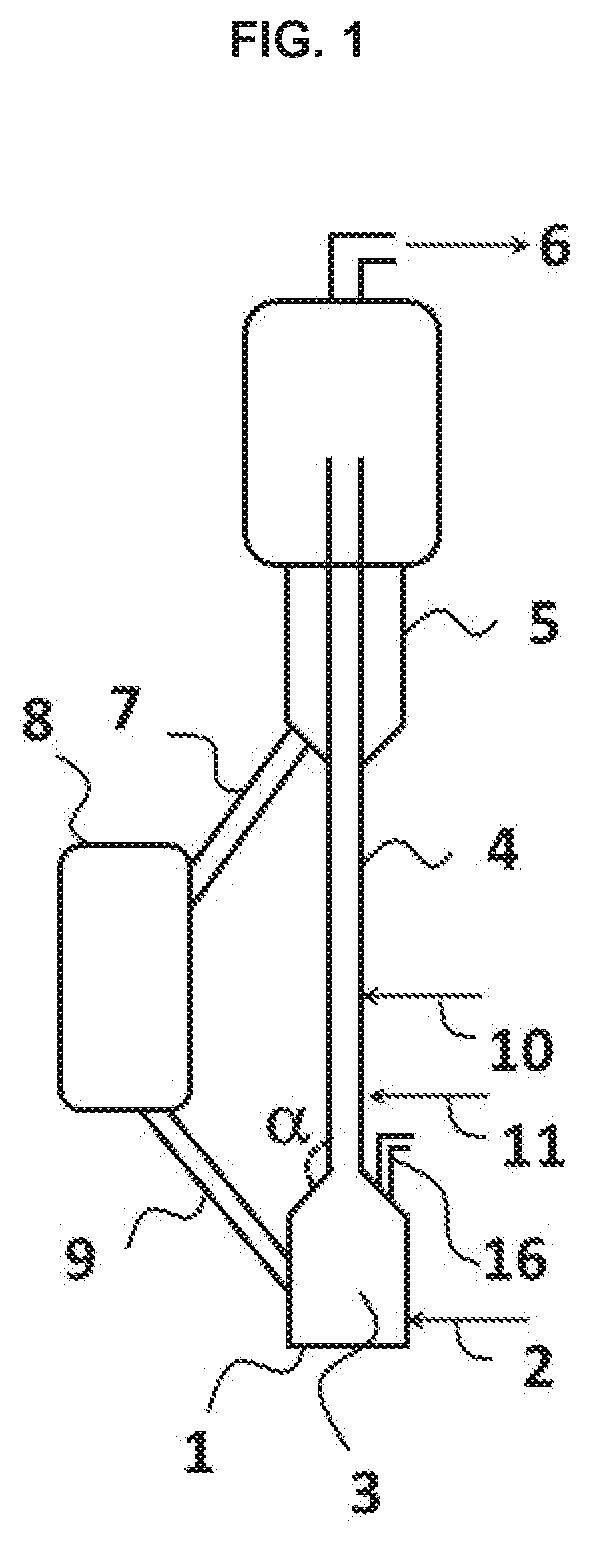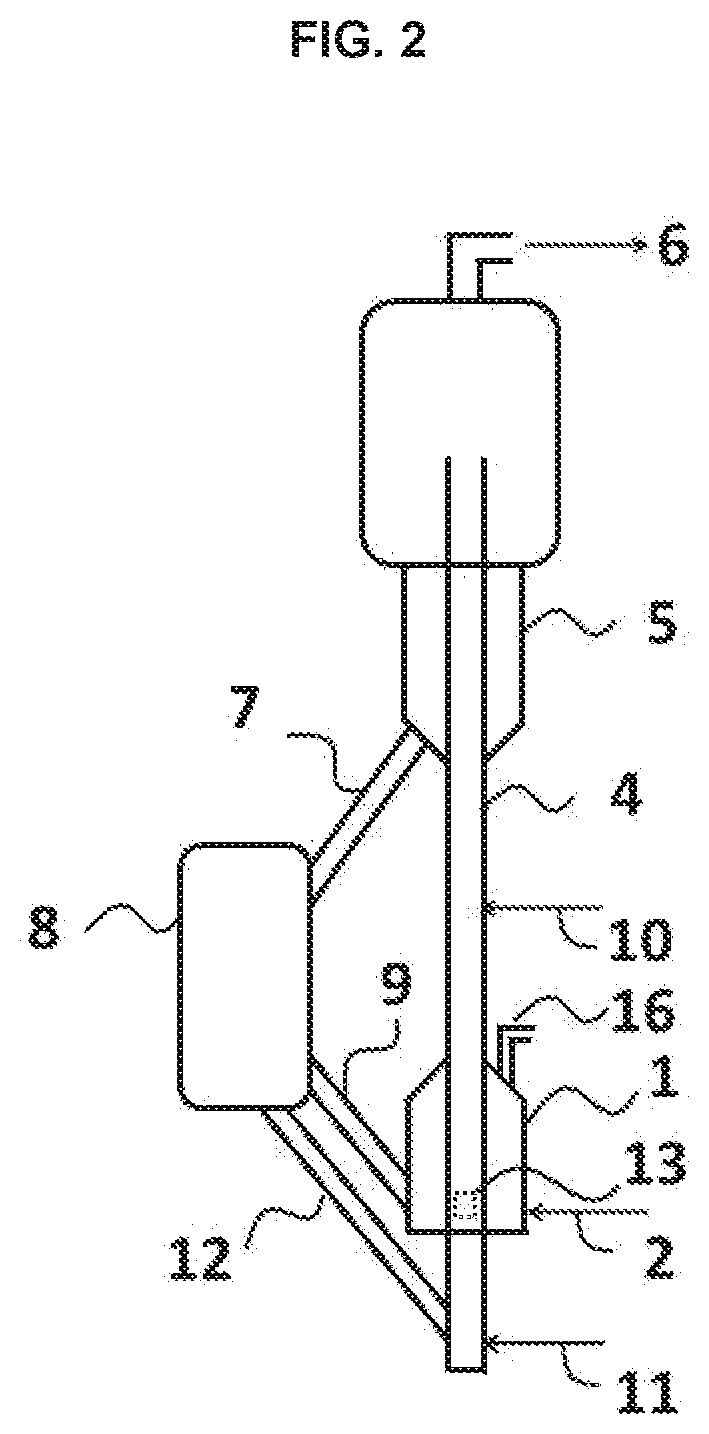Conversion of a crude oil in a fluidised bed comprising zones with different contact times
a technology of fluidised bed and crude oil, applied in the field of refining and petrochemistry, can solve the problems of more difficulty in cracking of lighter feedstocks, and achieve the effect of increasing synergy and maximizing the production of light olefins
- Summary
- Abstract
- Description
- Claims
- Application Information
AI Technical Summary
Benefits of technology
Problems solved by technology
Method used
Image
Examples
example 1
Conversion of a Light Feedstock as a Function of the Contact Time
[0109]The conversion of a gasoline feedstock resulting from direct distillation (naphtha straight run) was carried out for different contact times in a dense fluidized bed (FB) reactor composed of 40 g of catalyst, and also in a riser in which the contact time is markedly shorter.
[0110]The properties of the feedstock are given in the following table 1.
TABLE 1Density at 15° C.0.6905Paraffins (% by weight)33.7Isoparaffins (% by weight)41.3Olefins (% by weight)0Naphthenes (% by weight)19.2Aromatics (% by weight)4.1 5% Boiling point (° C.)52.250% Boiling point (° C.)69.795% Boiling point (° C.)100.2
[0111]The PIONA (characterization of compounds of n-Paraffin, Isoparaff in, Olefin, Naphthene, and Aromatic type) of the feedstock is presented in the following table 2.
TABLE 2PIPONAC52.310.390.000.000.00C623.2421.200.0010.742.54C78.1219.190.007.801.54C80.000.460.000.610.01C90.000.020.000.030.00Total33.6741.260.0019.184.09
[0112]...
example 2
Yield of Light Olefins as a Function of the Contact Time
[0116]For the same feedstock as that presented in the preceding example, the structure of yield of light olefins as a function of the contact time, obtained in a riser (for the lowest contact time) and in a dense fluidized bed (FB), is shown in the following table 4.
TABLE 4Contact time (ms)150570107020754080TechnologyRiserFBFBFBFBC2 olefins (ethylene)*7.38.610.915.520.3C3 olefins (propylene)*14.116.718.719.317.6C4 olefins (butenes)*6.266.26.25.5Total olefins*27.631.335.84143.4Gain*013%30%49%57%*% by weight with respect to the feedstock
[0117]The contact time can be adjusted according to the product target. In this example, a contact time close to 2075 ms makes it possible to obtain mainly propylene but it is can be advantageous to continue to increase it, for example to 4080 ms, with the emphasis on maximizing the olefins.
example 3
Optimum Contact Time According to the Feedstocks
[0118]It is shown, in the following table 5, that, for two different feedstocks, the contact time fixed in order to obtain similar yields of light olefins is higher for the lightest feedstock (1454 ms for the feedstock with a density of 0.6905; 2652 ms for the feedstock with a density of 0.67305).
TABLE 5FeedstocksDensity 15° C.0.69050.67305 5% Boiling point (° C.)55.23595% Boiling point (° C.)100.260Operating conditionsTemperature (° C.)680680Contact time (ms)14542652YieldsDry gas (% by26.8028.50weight / feedstock)H2 (% by weight)0.570.54C1 (% by weight)4.546.99C2 (% by weight)6.256.10C2 = (% by weight)15.4514.87LPG (% by weight)33.7530.49C3 (% by weight)6.423.57C3 = (% by weight)19.3519.61Total C4 (% by weight)1.591.02iC4 (% by weight)0.600.35nC4 (% by weight)0.990.67Total C4 = (% by weight)6.406.19iC4 = (% by weight)2.523.64nC4 = (% by weight)3.882.55C4 == (% by weight)0.000.10
PUM
| Property | Measurement | Unit |
|---|---|---|
| temperature | aaaaa | aaaaa |
| temperature | aaaaa | aaaaa |
| temperature | aaaaa | aaaaa |
Abstract
Description
Claims
Application Information
 Login to View More
Login to View More - R&D
- Intellectual Property
- Life Sciences
- Materials
- Tech Scout
- Unparalleled Data Quality
- Higher Quality Content
- 60% Fewer Hallucinations
Browse by: Latest US Patents, China's latest patents, Technical Efficacy Thesaurus, Application Domain, Technology Topic, Popular Technical Reports.
© 2025 PatSnap. All rights reserved.Legal|Privacy policy|Modern Slavery Act Transparency Statement|Sitemap|About US| Contact US: help@patsnap.com



